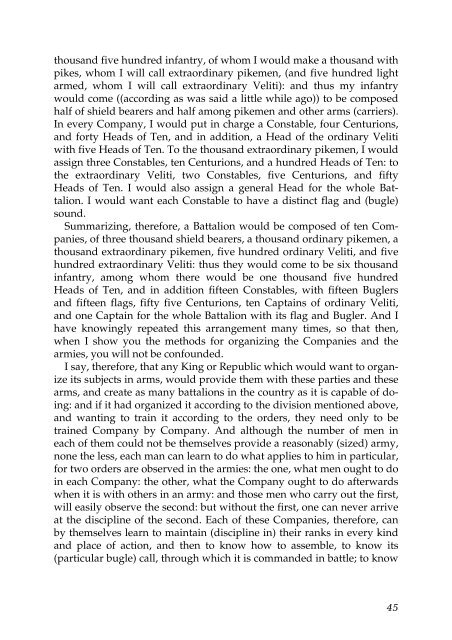You also want an ePaper? Increase the reach of your titles
YUMPU automatically turns print PDFs into web optimized ePapers that Google loves.
thousand five hundred infantry, <strong>of</strong> whom I would make a thousand with<br />
pikes, whom I will call extraordinary pikemen, (and five hundred light<br />
armed, whom I will call extraordinary Veliti): and thus my infantry<br />
would come ((according as was said a little while ago)) to be composed<br />
half <strong>of</strong> shield bearers and half among pikemen and other arms (carriers).<br />
In every Company, I would put in charge a Constable, four Centurions,<br />
and forty Heads <strong>of</strong> Ten, and in addition, a Head <strong>of</strong> the ordinary Veliti<br />
with five Heads <strong>of</strong> Ten. To the thousand extraordinary pikemen, I would<br />
assign three Constables, ten Centurions, and a hundred Heads <strong>of</strong> Ten: to<br />
the extraordinary Veliti, two Constables, five Centurions, and fifty<br />
Heads <strong>of</strong> Ten. I would also assign a general Head for the whole Battalion.<br />
I would want each Constable to have a distinct flag and (bugle)<br />
sound.<br />
Summarizing, therefore, a Battalion would be composed <strong>of</strong> ten Companies,<br />
<strong>of</strong> three thousand shield bearers, a thousand ordinary pikemen, a<br />
thousand extraordinary pikemen, five hundred ordinary Veliti, and five<br />
hundred extraordinary Veliti: thus they would come to be six thousand<br />
infantry, among whom there would be one thousand five hundred<br />
Heads <strong>of</strong> Ten, and in addition fifteen Constables, with fifteen Buglers<br />
and fifteen flags, fifty five Centurions, ten Captains <strong>of</strong> ordinary Veliti,<br />
and one Captain for the whole Battalion with its flag and Bugler. And I<br />
have knowingly repeated this arrangement many times, so that then,<br />
when I show you the methods for organizing the Companies and the<br />
armies, you will not be confounded.<br />
I say, therefore, that any King or Republic which would want to organize<br />
its subjects in arms, would provide them with these parties and these<br />
arms, and create as many battalions in the country as it is capable <strong>of</strong> doing:<br />
and if it had organized it according to the division mentioned above,<br />
and wanting to train it according to the orders, they need only to be<br />
trained Company by Company. And although the number <strong>of</strong> men in<br />
each <strong>of</strong> them could not be themselves provide a reasonably (sized) army,<br />
none the less, each man can learn to do what applies to him in particular,<br />
for two orders are observed in the armies: the one, what men ought to do<br />
in each Company: the other, what the Company ought to do afterwards<br />
when it is with others in an army: and those men who carry out the first,<br />
will easily observe the second: but without the first, one can never arrive<br />
at the discipline <strong>of</strong> the second. Each <strong>of</strong> these Companies, therefore, can<br />
by themselves learn to maintain (discipline in) their ranks in every kind<br />
and place <strong>of</strong> action, and then to know how to assemble, to know its<br />
(particular bugle) call, through which it is commanded in battle; to know<br />
45
















